How Can I Download This Video Again Flat Belly Fix Lying Side Hip Flexor Stretch
Get full access to Outside Learn, our online education hub featuring in-depth yoga, fitness, & nutrition courses, when you sign upwards for Outside+.
Nosotros've got bad news for the desk-sitters out there: All that sedentary time staring at a screen is doing a number on your health. Non but has too much sitting been linked to serious health problems, similar obesity and osteoporosis, among others, but it also is a meaning contributor to that nagging lower dorsum ache that y'all've been complaining near. But it'due south not actually your back that'south the consequence: It's your hip flexors.
While sitting, your hip flexors constantly remain in a flexed position. Over time, sitting too much will cause these muscles to shorten and compress, limiting your ability to fully straighten the hip when you're finally upright again. When your hip flexors are as well tight, they pull down and forward on the pelvis, which tilts it forward and compresses the lower back. Congratulations, now you have back pain!
And so what'south a yogi to do? Yoga, of course. You tin apply your practise to get-go the furnishings of all that sitting, stretch the hip flexors, relieve associated back pain, and gear up the stage for a safe do of intermediate poses like backbends.
See likewise: 8 Yoga-Based Stretches to Relieve Tight Hips
What exactly are the hip flexor muscles?
Several muscles cross the front of the hip and create hip flexion, pulling the thigh and trunk toward each other, but probably the most important is the iliopsoas. It is actually composed of ii muscles, the iliacus and the ever-mysterious psoas, which lie deep in the dorsum of the abdomen.
If you looked at the front of a trunk with the internal organs removed, you lot would run across the psoas lying alongside the spine, fastened to the sides of the lumbar vertebrae. The iliacus originates on the inner bowl of the pelvis. Both muscles cantankerous the floor of the pelvis, emerge at the outer edges of the pubic basic, and finally insert on the inner upper femur (thighbone). Because the muscles are buried so deep, we tin can't see or touch on them, and then it'southward like shooting fish in a barrel to sympathise why in that location is much confusion about their location and activeness. Simply trust us, these muscles are extremely important in building a balanced alignment, ensuring proper articulation rotation, and achieving a full muscular range of motion.
If you are standing, the hip flexors lift your leg when you step upwards on a stool. If you are lying flat on your back, the hip flexors can either lift your leg or elevator your body into a sit-up. In yoga, Navasana (Gunkhole Pose) is especially good at strengthening the iliopsoas because it demands that the musculus isometrically contract to hold upward the weight of the legs and torso.
See also: 7 Poses That Help Deepen Your Awareness to Release the Psoas
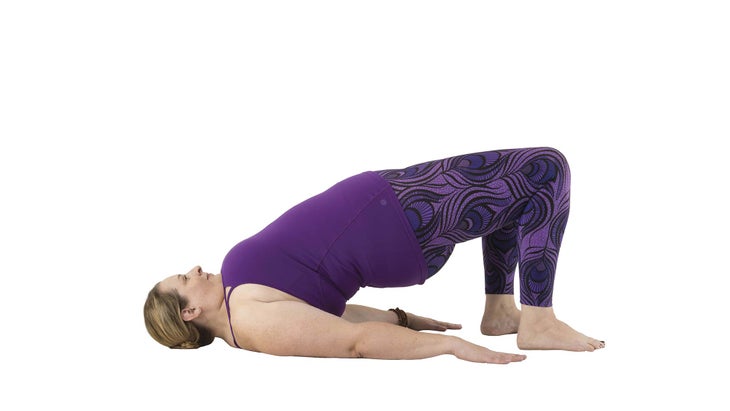
How hip flexors lose flexibility
Nearly problems with the hip flexors don't originate in a lack of forcefulness merely in a lack of flexibility. To sympathize how these muscles lose their flexibility, imagine someone with a broken arm, her aptitude elbow encased in a plaster cast. When the cast is removed after six or eight weeks, the soft tissues effectually the elbow (muscles, tendons, ligaments, and even skin) will have shortened, and the elbow won't immediately straighten out. Information technology volition take the patient stretching over several weeks to restore the full range of motion. Similarly, if the hip is constantly kept in a flexed position, like sitting, for hours every twenty-four hours, mean solar day after mean solar day, the hip flexors will shorten and shrink, limiting your power to fully extend the hip.
If the iliopsoas and other hip flexors are tight, they pull down and forward on the pelvis, which tilts the pelvis forrad and compresses the lower back. Picture show a human standing with the forepart of his pelvis tilting forward and his tailbone lifting. To stand upright, he has to overarch his lower dorsum. Anatomically, this is chosen hyperextension; normally, it's chosen "swayback." Prolonged continuing or sitting in this position increases pressure on the facet joints of the lower spine, which in turn can contribute to arthritis in those joints.
With the all-time of intentions, yoga students sometimes create a muscle imbalance betwixt the hamstrings and the hip flexors that contributes to an anterior (forward) pelvic tilt. About yoga practitioners work long and hard to improve their hamstring flexibility merely spend much less time stretching their hip flexors. Somewhen, the hamstrings lengthen significantly, while the hip flexors meliorate merely slightly. The issue: The relatively tighter hip flexors tip the pelvis forward because the relatively longer hamstrings no longer exert an equal counterpull on the sitting bones of the pelvis.
Meet as well: vii Poses to Release Those Tight Hamstrings
If the hip flexors are tight, the resulting anterior pelvic tilt and lumbar hyperextension volition cause issues in many yoga poses, including standing poses similar Virabhadrasana Ii (Warrior Pose II) and Trikonasana (Triangle Pose), in which the primary leg activeness is opening to the sides instead of flexing forwards or extending dorsum.
The real issues begin, however, in poses requiring full extension (straightening) of the hip joint. These poses include backbends such as Setu Bandha Sarvangasana (Bridge Pose) and Urdhva Dhanurasana (Upward-Facing Bow Pose), where both hips are extended, and standing poses like Virabhadrasana I (Warrior Pose I) and Virabhadrasana Three (Warrior Pose III), in which the legs open forward and backward (front leg hip flexed, back leg hip extended). In all these poses, tight hip flexors can cause painful compression in the lower back, a fairly common problem in backbends.
Encounter besides: 6 Yoga Poses to Help Better Flexibility
4 yoga poses to effectively stretch your hip flexors
For people in a sedentary lodge, daily hip flexor stretches are important to help weigh the prolonged hip flexion of sitting for hours. They are too an of import preparation for backbends, assuasive the hips to extend fully then we tin can avoid compression in the lower back.
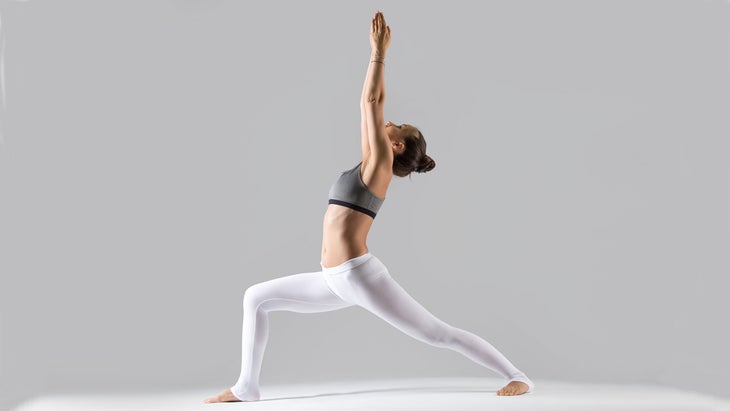
Come across your ASIS in Virabhadrasana I (Warrior I)
If done with proper alignment, Warrior Pose I tin be a wonderful hip flexor stretch. Stand up with one leg forward and ane leg back, ready for Warrior I. Put your fingers on the front pelvis basic: You should be able to feel a small, circular protuberance on each side, chosen the anterior superior iliac spine, or ASIS.
The ASISes are good indicators of the tilt of the pelvis. On the side of the pelvis with the extended hip (the back leg), the iliopsoas will try to pull the pelvis and lumbar spine downward and forward into an anterior tilt. To counter this, use your fingers to bear witness the ASISes how to elevator upwardly. Hold this posterior tilt equally you bend the front knee, keeping the back articulatio genus directly and the back heel grounded. Feel the iliopsoas lengthen and visualize the spine lifting out of the pelvis.
Yous tin can also piece of work with the pelvic alignment in Warrior I by bringing your sensation to the lower dorsum and back of the pelvis. Concur or necktie a belt around your waist. As you motility into Warrior I, don't let your ASISes driblet down and forrard and your tailbone lift upwards.
Instead, motion your back waist into the chugalug, motion your tailbone downwardly away from the belt, and lift the spine up out of the belt. The belt becomes a point of orientation to assistance you align your pelvis and get a deep iliopsoas stretch.
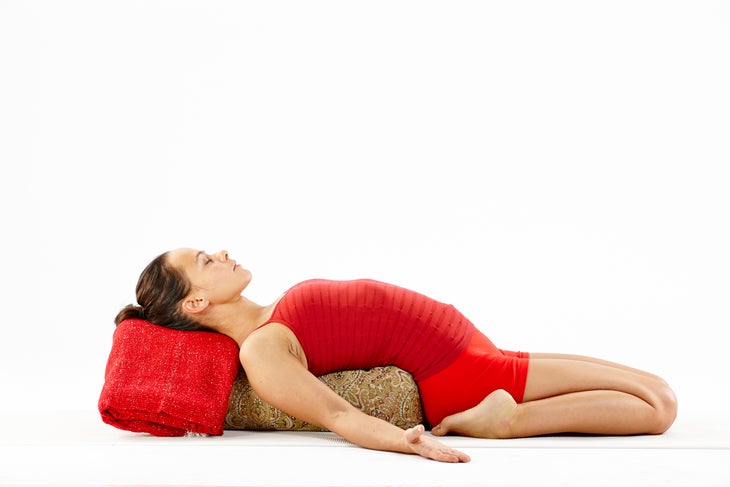
Stretch your rectus femoris in Supta Virasana (Reclining Hero Pose)
Another muscle, the rectus femoris, can as well limit hip flexion and crusade problems in yoga poses. Function of the quadriceps muscle on the front of the thigh, it originates near the ASIS, runs down the center of the thigh, and inserts on the shinbone (tibia) just beneath the knee joint. When the rectus femoris contracts and shortens, it not only extends or straightens the genu, it as well flexes the hip.
To stretch the rectus femoris, we demand a pose that flexes the knee and extends the hip, like Supta Virasana (Reclining Hero Pose). As you sit down between your heels and prevarication dorsum in this pose, the rectus femoris lengthens.
If it isn't long plenty to allow the pelvis to tilt all the way back, compression and discomfort in the lower back can occur. To stretch the rectus femoris without compressing the lower dorsum, place a bolster or folded blankets comfortably under your back in Supta Virasana, with enough pinnacle to go on some length in the lower back.
See as well Got Tight Quads? Yes, You Can However Enjoy Supta Virasana
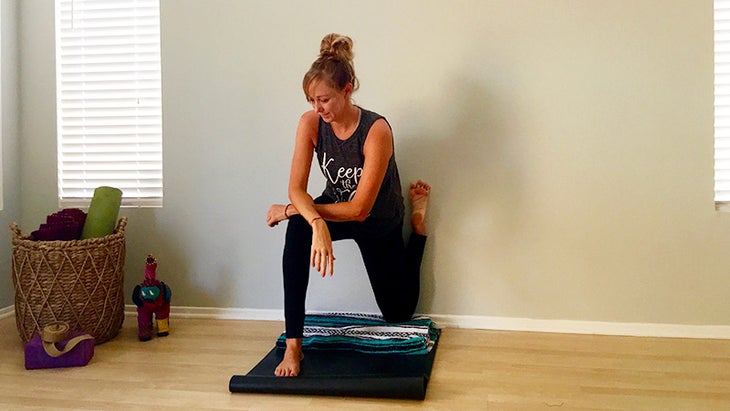
Encompass intensity in King Arthur'southward Pose
Alternately, try King Arthur'due south Pose: Starting on easily and knees with your feet near a wall, put your correct shin direct up the wall and bring your left foot frontward so information technology's under the left knee joint. Place your easily on your genu and lift your spine straight upwardly while taking your tailbone down. You should experience a strong stretch on the front part of your thigh.
See besides: Do Less, Relax More: Legs-Up-the-Wall Pose
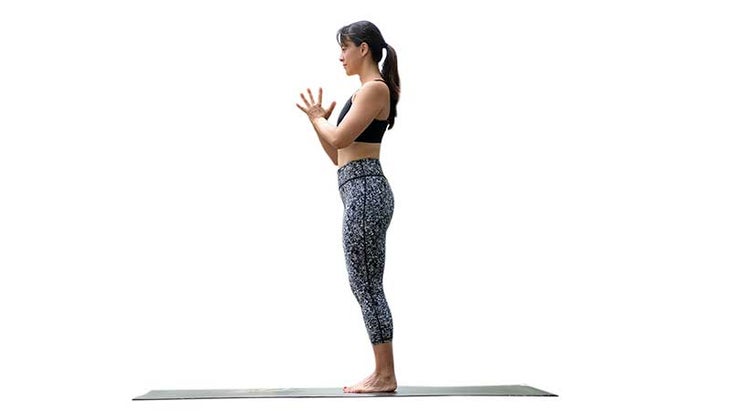
Develop awareness of your pelvic tilt in Tadasana (Mountain Pose)
If you tend to stand with a "swayback," developing awareness of the opening at the front end of your hips is especially important. In Tadasana (Mount Pose), exercise lifting the ASISes, moving the tailbone downwards, and lifting the lumbar spine. Putting a belt effectually your waist, as you did in Warrior I, may help y'all increase your awareness of your pelvic alignment in this pose, too.
Frequently people try to right a forward tilt of the pelvis past gripping with the intestinal muscles. Simply besides limiting your breathing and being counterproductive in backbends, gripping the abdominals won't control the anterior pelvic tilt if you take tight hip flexors—not even in unproblematic standing postures. That'southward why it's so important to brand hip flexor stretches function of your daily practice, peculiarly later a long day of sitting. These poses volition permit you lot enjoy a new sense of space in your pelvis—and assistance protect you from compression and pain in your lower dorsum.
Want more? Here are 6 Poses for Tight Hip Flexors
Liked this article? Join Outside+ and become unlimited access to sectional manufactures, sequences, meditations and live experiences—likewise as thousands of healthy recipes and repast plans from Clean Eating and Vegetarian Times, plus can't-miss content from more than 35 other make like Women's Running, Backpacker, and Better Nutrition.

Source: https://www.yogajournal.com/poses/get-hip-about-flexors/
0 Response to "How Can I Download This Video Again Flat Belly Fix Lying Side Hip Flexor Stretch"
Post a Comment